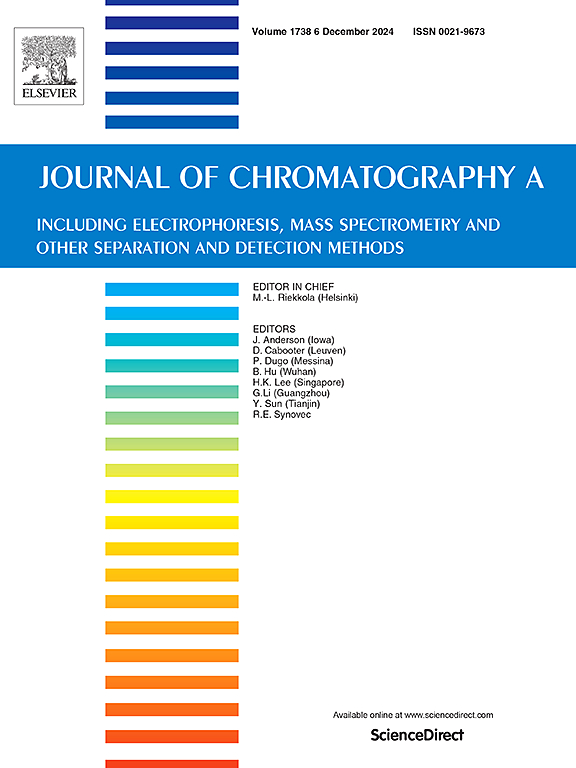Hydrophobic natural deep eutectic solvents as a green desorption media for parabens from solid sorbents: A proof-of-concept study
IF 4
2区 化学
Q1 BIOCHEMICAL RESEARCH METHODS
引用次数: 0
Abstract
A sustainable sample preparation method was developed to determine the concentrations of four parabens (methyl, ethyl, n-propyl, and n‑butyl paraben) in human urine. Initial experiments evaluated three sorbents, C18, PSA, and Florisil®, combined with different methanol and water (MeOH:H₂O) elution strategies. The best performance was achieved using 50 mg of C18 with 500 µL of MeOH:H₂O (80:20, v/v), which was selected as the reference protocol. The method was then redesigned to incorporate a hydrophobic natural deep eutectic solvent (H-NADES) composed of DL-menthol and acetic acid (MAc) in a 1:2 molar ratio as an alternative desorption solvent, along with ultrasound-assisted desorption. A Box–Behnken design was performed to optimise key variables: H-NADES volume, ultrasound time, extraction temperature, and phosphate buffer volume. Other variables, such as HPLC-UV conditions and sorbent type, were evaluated using an univariate approach. The final conditions (200 µL H-NADES and 30 minutes of sonication at 40 °C) provided valuable recoveries. The H-NADES method reduced solvent volume and environmental impact compared to the proposed protocol. The method exhibited good linearity (0.017–50 µg mL-1), precision (RSD < 10%), and low detection limits (0.006–0.022 µg mL-1). In addition, green chemistry metrics, AGREE (0.70), AGREEprep (0.48), and ChlorTOX (1.42 g), supported the environmentally friendly performance of the procedure. This work demonstrates that green alternatives based on H-NADES can replace conventional solid-phase protocols using organic solvents, without compromising analytical performance. The developed method offers a simple and eco-friendly approach for an alternative routine biomonitoring of parabens in complex biological matrices.
疏水天然深共晶溶剂作为固体吸附剂对羟基苯甲酸酯的绿色解吸介质:概念验证研究。
建立了一种可持续的样品制备方法,用于测定人体尿液中四种对羟基苯甲酸酯(甲基、乙基、正丙基和正丁基对羟基苯甲酸酯)的浓度。最初的实验评估了三种吸附剂,C18, PSA和Florisil®,结合不同的甲醇和水(MeOH:H₂O)洗脱策略。选用50 mg C18和500µL MeOH:H₂O (80:20, v/v)作为参比方案,效果最佳。然后重新设计该方法,加入由dl -薄荷醇和醋酸(MAc)以1:2摩尔比组成的疏水天然深共晶溶剂(H-NADES)作为替代解吸溶剂,并辅以超声辅助解吸。采用Box-Behnken设计优化关键变量:H-NADES体积、超声时间、提取温度和磷酸盐缓冲液体积。其他变量,如HPLC-UV条件和吸附剂类型,使用单变量方法进行评估。最终条件(200µL H-NADES和40°C下30分钟的超声)提供了有价值的回收率。与提出的方案相比,H-NADES方法减少了溶剂体积和对环境的影响。该方法线性良好(0.017 ~ 50µg mL-1),精密度(RSD < 10%),检出限低(0.006 ~ 0.022µg mL-1)。此外,绿色化学指标,AGREE (0.70), AGREEprep(0.48)和ChlorTOX (1.42 g),支持该过程的环保性能。这项工作表明,基于H-NADES的绿色替代品可以取代使用有机溶剂的传统固相方案,而不会影响分析性能。所开发的方法为复杂生物基质中对羟基苯甲酸酯的常规生物监测提供了一种简单而环保的替代方法。
本文章由计算机程序翻译,如有差异,请以英文原文为准。
求助全文
约1分钟内获得全文
求助全文
来源期刊

Journal of Chromatography A
化学-分析化学
CiteScore
7.90
自引率
14.60%
发文量
742
审稿时长
45 days
期刊介绍:
The Journal of Chromatography A provides a forum for the publication of original research and critical reviews on all aspects of fundamental and applied separation science. The scope of the journal includes chromatography and related techniques, electromigration techniques (e.g. electrophoresis, electrochromatography), hyphenated and other multi-dimensional techniques, sample preparation, and detection methods such as mass spectrometry. Contributions consist mainly of research papers dealing with the theory of separation methods, instrumental developments and analytical and preparative applications of general interest.
 求助内容:
求助内容: 应助结果提醒方式:
应助结果提醒方式:


